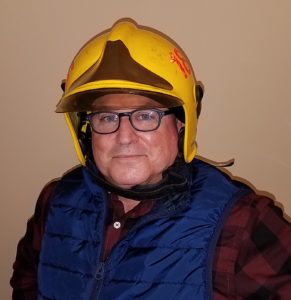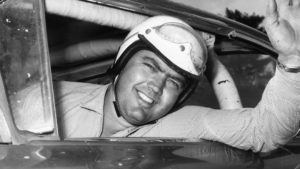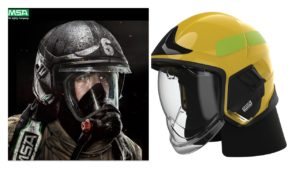By: Robert Avsec, Executive Fire Officer
So, what did you think of my recent post (Overcoming the #1 Barrier to Cultural Change in the Fire Service)? Gotcha thinking, didn’t it? Well, that’s what I hope for whenever I put my fingers to the keyboard and start writing one of these things.
Included with last week’s post was a photograph of yours truly modeling a European-style helmet. The helmet is from Finland and

The author wearing a European-style helmet from Finland. MSA has unveiled a similar helmet in the U.S. that includes an integrated radio microphone and retractable face shields–like this model–and full wrap around protection. Wonder how long it will take to gain acceptance in U.S.?
it’s just one amazing object that can be found in the personal fire station and museum that’s the proud passion of my friend and colleague, Dr. Will Brooks, in Lunenburg, Nova Scotia.
Now I’m a huge fan of this style of fire helmet that worn by firefighters in practically every other country in the world except for the U.S. and Canada.
I’ve never liked the back brim of our fire helmets because for short firefighters (Me being 5-feet, 4-inches in height) the brim is always banging against the top of our SCBA cylinder (e.g., when looking up or trying to raise your head and look forward while crawling). And the high crown and front piece doesn’t work very well in the tight confines of auto extrication or other tight spaces firefighters get into.
Video Chief Conversations: MSA debuts new XF1
That’s Executive Editor (For both FireRescue1 and Fire Chief) Chief Marc Bashoor getting the “scoop” on the new MSA Cairns XF1 firefighter helmet. Bashoor asks how reception has been to the non-traditional jet helmet shape of the XF1, which Buzard (The MSA rep) says “has been warm.”
Buzard related the “light switch moment” when he realized the need for a streamlined helmet, when he came across a motor vehicle accident with firefighters on scene, and witnessed three firefighter helmets sitting on top of the car, obviously not being worn during the rescue operation.
Of course not! That’s what we do in the fire service. If it doesn’t fit, we make it fit. If it doesn’t work, we don’t use it. And if we don’t like it, we sure as hell ain’t gonna use it!
The Great Helmet Debate with Jerry Helm – Code 3 Podcast
But then I keep going back to Firefighter Life Safety Initiative No. 8 (one of the 16 Life Safety Initiatives from Everyonegoeshome.com) which states: Utilize available technology wherever it can produce higher levels of health and safety. So, why do we firefighters in the U.S. and Canada cling to our current fire helmet designs? It’s not because of comfort. It’s not because of functionality. And it’s not because of safety.
Many firefighters are fans of motorsport racing, especially auto racing, NASCAR auto racing! Now look at the head protection worn by one of the sport’s early star drivers, Junior Johnson:

Stockcar Racing Champion Junior Johnson wearing 1960’s era head protection.
Contrast that with the current head and neck support (HANS) device used by current NASCAR drivers like Jimmie Johnson.
Does any NASCAR fan think that Jimmie Johnson is a lesser man or lesser racer because his sport has progressed to better head and neck protection for its drivers?
A helmet must be more than just head protection
Hearing loss for firefighters is a real risk of the job, so does your helmet provide hearing protection just by putting it on? Eye injuries are another risk of firefighting and other emergency service delivery tasks (e.g., auto extrication). Does your helmet have built-in full-face protection that’s protected from heat and physical damage until you need it?

Modern NASCAR head and neck support (HANS) system being used by current NASCAR star Jimmie Johnson.
You see where I’m going with this, right? If, before you started out as a new firefighter, you were presented with all the different hazards that can be present on the job, and had to select your firefighter helmet based strictly on which was best at reducing your exposure to those hazards, which one would you pick? I’ll make it easier for you with a side-by-side comparison:
|
Hazards |
Traditional Style Helmet (U.S. and Canada) |
European-style Helmet |
| Eye injuries from foreign objects | Must use goggles or full-face shield that is stored externally and subject to heat and physical damage and scratching. | Built-in retractable full-face shields in both clear and tinted configurations. |
| Hearing loss from exposure to high noise environments | None. Must use external hearing reduction equipment (e.g., foam earplugs earmuffs) | Design of helmet provides full coverage to entire head except for face providing built-in hearing protection. |
| Head injuries caused by side impacts | No protection | Design of helmet provides full coverage to entire head except for face (See above). |
Does your current firefighter helmet have integrated communications hardware (e.g., earphones and external microphone that can be stowed away when not in use? Does your firefighter helmet provide you with unrestricted head movement (up and down, side to side, rotation to left and right)?

MSA Cairns XF1 Firefighter Helmet (Photo source: http://us.msasafety.com/
European-style firefighter helmets do. And, so does the new MSA Cairns XF1 firefighter helmet. So, how long do you think it’s going
to take before a significant number of firefighters in the U.S. and Canada make the switch?
I think it’s going to take a grassroots effort by the leadership of some smaller departments having the courage to buy one for every member of their department—including one for themselves—and stipulating that from X date forward the new helmet will be the only one used for all activities within the department, including training.
I know there’s a cost factor here, but some things just need to get done and if we’re serious about any of the 16 Firefighter Life Safety Initiatives it should be #8. Why are we still protecting 21st century firefighters with 19th or 20th century “technology” (In terms of their firefighting helmet)?
Consider this. When any of the military services in the U.S. or Canada find, through their research (And they do a bunch of research on such stuff), identify a better [Fill in the blank] they don’t ask their personnel if they want to use the new [Fill in the blank] or keep using their old version. And they don’t issue the new [Fill in the blank] to only new personnel entering the service.
So, why don’t we do business like that?
 Fire & EMS Leader Pro The job of old firefighters is to teach young firefighters how to become old firefighters!
Fire & EMS Leader Pro The job of old firefighters is to teach young firefighters how to become old firefighters!